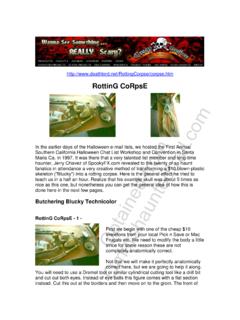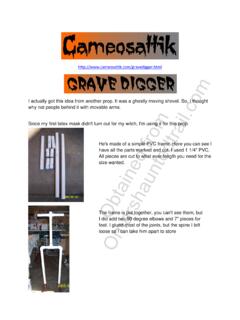Transcription of So you want to build a pneumatic prop?
1 So you want to build a pneumatic prop ? SkeletalRemains SkeletalRemains is offline So you want to build a pneumatic prop ? I just wanted to toss this out and see who was interested. (If enough people are interested and respond to this thread, I will post follow-ups with pics on how to hook up everything you need to run the pneumatics from the solenoid to the cylinder.). I noticed that so many people are interested in pneumatics, me too! You see, I love Halloween and haunted houses (like all of you), and have for a number of years. Many years ago, I was scouring websites looking for ideas and how-tos on building pneumatic props. I built a few out of knick-knacks, spare parts and lumber around the garage, screen-door closers, etc. But I spent a TON OF MONEY trying to build just a few props because I had to see with my own eyes what worked and what didn't.
2 I really tried to modularize this whole ' pneumatic prop ' thing in my head, but could never do it. Fast forward several years later, and I am proud to say that I am now the lead tech at a huge haunted house in North Texas. I owe a lot of people for that title, especially since I really had to pay close attention when opportunities arose, learn a lot on my own, and take initiative when required. You wouldn't believe what I have to go thru in October when we are operating. As October is always fun, the off-season is what I love, and can't wait for, since it feels like I now have a clean slate to work from. For example, a few years ago, I built my first drop panel, and it broke the first night. I fixed it and it broke the second night, and the third, fourth, because I hadn't figured out what worked. Now through that experience, I have a design that often lasts all season without breaking once, and we're talking about 5000+ drops.
3 (And I can make one in about 2-3 hours, when the first one took me 2 days). The same idea with props, I learned what works and what doesn't, and it has really elevated my level of expertise with these devices. I thought I was the rookie, but it turned out that all of a sudden, I knew more about pneumatics than most of the people around me. All in all, it really is simple, it's just that it is often difficult to wrestle these secrets away from the haunt pros, so every major yard haunter in the nation (and there are probably hundred's of thousands if not millions). has to spend a fortune at home depot for trial and error, and since most yard haunters only operate one night a year, there isn't enough practical test time to learn all of this and troubleshoot stuff and try new things, Anyway, I am including some suggestions below for anyone that wants to make their first pneumatic prop for their haunt this year, based on my experience.
4 Obtained from This is some of what I have learned over the past few years working on pneumatics in a pro haunt: 1. Pick just one single-action prop to build , and get it straight in your head exactly how you want it to work, and forget everything else. Multiple-action props typically require controllers (brick/minibrick/parallax/etc), and you do not want to try to tackle a complex prop the first time around. 2. Sketch out your prop on paper to the best of your ability (even if you're not a great artist, I. especially am no ). Use your tape measure to get ballpark lengths of each piece and how much material you will need. Draw in your pneumatic cylinder wherever it makes sense, don't worry about what length, type, etc. Too many people just buy cylinders and MAKE them fit a prop no matter what, which can be done to an extent in my opinion, but this can easily be taken to extremes.
5 Use pictures of props on the web to get your general design, there are plenty of ideas out there. 3. Go to home depot or lowes and get a couple of those yardstick-sized paint stirs, and a cheap little box of nuts and bolts, the small You can build a replica from this material to test the actions of your prop mechanism. Just cut the stirs with a little saw, and drill a pilot in the ends and bolt it all together. If the holes aren't right make another hole and test it out. You don't have to build the whole base, etc, just enough so that you know how the mechanism will work and if it is working to your expectations. Make sure that the 'math' as it applies to leverage is reasonable, and that the cylinder is positioned in a way so that it doesn't need 100psi to get the first 3 inches off the ground, and then only 35psi the rest of the way. The cyl should have relatively equal load throughout it's stroke.
6 4. Decide on material. OK, here's where it get's tough. To be honest, nearly every commercial prop is built out of steel and welded, but it's not realistic that each person who wants to build a prop is going to know how to weld or even have a welder or a facility to use one. So, a good hacksaw and a box of stainless 3/8" bolts, washers, and lock nuts is the next best thing. 5. Put together a budget for this thing. You already spent 7-8 dollars on stirs and small bolts, but here is where you need to make a commitment on cost. It will probably cost you about $100 to build a reliable, reasonably-sized prop , give or take, depending on how good of a deal-finder you are on eBay. 6. Buy the parts, build the mechanism. This really isn't that tough, and pretty much anyone on here can do that. 7. Pneumatics, this is the fun part. OK, go out and find a suitable cylinder on eBay.
7 Get a Bimba or SMC or other good brand. If your drawing shows your cyl mounted in the back, go for a pivot- mount cyl, if it mounts in the front, go for a nose-mount cyl. A lot of times you'll find one cyl that has both mounting options. 8. If you're making a pop-up, you can probably use a 3-way solenoid valve no problem, since the prop will come up at the same speed it will come down. If you're using a lifter or popout, you may wany to use a 4-way solenoid valve, which will allow you to adjust the rate of descent of the prop differently that ascent. This is great for props that pop fast, but need to reset slowly as not to come slamming down so hard. You can find these on eBay pretty easy. MAC or SMC makes them, as well as ASCO. Just search on eBay for those names under the Business/Industrial Supply, and stay away from pilot valves, as they are air actuated and defeat the purpose of an electrical trigger.
8 9. Use polyethylene tubing with push-in quick-connects, not barbs. Lowes carries the quick- Obtained from connects now but they are pricy. Instead check out and find instant-fittings. They are cheap and ship fast. The tubing is $ for 100' any color for 1/4" tubing. Make sure you buy all 1/4" fittings for the tubing, and most likely either 1/8" or 1/4" for the solenoid fittings. 9. Run triggered power to your solenoid. Whatever the voltage on your solenoid, use a piece of PVC, and a pushbutton switch from Radio Shack, workes great every 10. OK, whatever else you want to know, just post in this thread and I will try to help you out with anything I can. All of the people here are so nice and offer so much assistance, so I just want to do the same. What can I say? I love working on And since you read all the way through this long post, I have included a pic of one of our ScareFactory props below (actually it belongs to our friend Gary, another pro haunter).
9 You can see me on the left with my hand on the dog's butt. (holding him up while he's broken) I fixed him up and he jumped thousands of times this By the way, you can easily use a 5HP 20gal compressor to run your props. Unless you have 5 air cannons running off this compressor, you'll be ok up to about 5 props, give or take, maybe more if you're using low pressure props. OK, don't kill yourself, compressed air is dangerous! I am not First, a cylinder You basically have two major types of cylinders available for haunt uses. I will classify those as single-acting and dual-acting. A single acting cylinder is like a screen door closer, air only moves one way through a single port, and a spring retracts it when air is removed. A dual-acting cylinder has two ports, one on each side of the piston rod end, and air is reversed back and forth thru those ports to activate and reset the cylinder's extent.
10 Next, a solenoid 1. An air 'valve' is a typical manual/hand operated air cutoff. When you turn it on manually, it lets air thru, when you close, the air stops going thru. Obtained from 2. An air 'solenoid valve' is an automatic valve that is operated by an electrical solenoid (coil). 3. An air 'pilot valve' is an automatic valve that is operated by another air source. When air is applied to the pilot valve, the valve activates. Think of a pilot valve as a relay for air instead of electricity. You can use a small pulse of air to control a larger source, just like a relay. For Haunt purposes, I suggest sticking with solenoid valves. Now, please note that solenoid valves typically have a single coil, which is reset by a spring when deactivated. But valves do exist that have coils on each side of the plunger. You can still use them, you just need a relay wired up to use them correctly.




